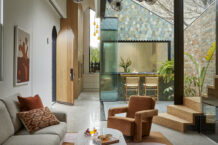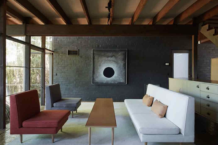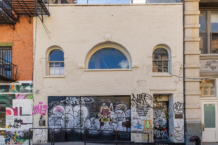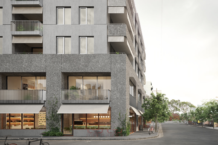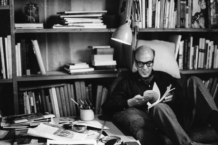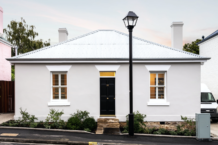Curating Walter Van Beirendonck & Belgian Fashion at MoMu Antwerp
Arts & Events, Design - by Lou Weis
Kaat Debo is the director of the Mode Museum (MoMu) in Antwerp, the museum devoted to Belgian fashion that also shares its premises with the Royal Academy of Fine Art, the world famous art school that propelled names such as Martin Margiela, Ann Demulemeister and Dries Van Noten into fashion folklore.
Fashion designers, like film directors, are at the centre of an industrial process that involves a big community of talented people who all need to be successfully managed for the brand to become a global success. Six designers from one generation, known as the Antwerp Six, achieved this incredible task. Theyhave gone on to assist a younger generation, such as Dior creative director Raf Simons, to reach international stardom.
One of the Six, Walter Van Beirendonck, is currently the subject of a new exhibition Dream the World Awake that has just opened at RMIT Design Hub in Melbourne.
Originally curated and exhibited at MoMu by Kaat and her team, Dream the World Awake is a retrospective of Van Beirendonck’s truly wild, wonderful and ground-breaking designs form the past 25 years. While in Melbourne to open the exhibition, Kaat sat down with Lou Weis for a conversation around Walter’s ongoing contribution to Antwerp’s creative community; around museum curation and how to deliver a museum’s collection digitally as well as physically.
 Entrance to Walter Van Beirendonck: Dream the World Awake, RMIT Design Hub. (Pic: Peter Bennetts)
Entrance to Walter Van Beirendonck: Dream the World Awake, RMIT Design Hub. (Pic: Peter Bennetts)
Lou Weis: You are in Australia to accompany Walter Van Beirendonck and the opening events of the Dream the World Awake exhibition. Beirendonck is a hugely influential fashion designer. But I’m interested to know who he is for you, as a colleague and fellow Antwerp fashion industry professional?
Kaat Debo: Walter is indeed one of our big names and as he is based in Antwerp, he remains very present. The MoMu museum where I am director is in the same building as the fashion department of the Royal Academy of Fine Arts, where Walter is director and is also teaches – so we meet each other often…
Walter is also someone who is active in collaborating and doing exhibitions and side projects. For example, a very important moment for Antwerp fashion was the exhibition in 2001 Landed that was curated by Walter, which also lead to the start of A Magazine (now known as A Magazine Curated By). The magazine has a whole different life now, however he did the first issue and I also took it over for two early issues.
Walter is also generally known around Antwerp – people know him, know his face from television appearances and generally know his work.
What other big talent is still based locally?
There are many other designers who also work near the museum. You have Dries Van Noten, who is only 10 minutes away from the museum, he has a huge domain with a beautiful, beautiful mansion on it… And then you have Raf Simons, who has his atelier and offices two streets away from the museum, and this is quite special I think.
LW: Are the people who helped found MoMu still part of it’s inner circle?
KD: Yes, some of them. At the exhibition opening at Design Hub last night, you would have seen Heird Bulot, who also worked on this exhibition. He’s one of the founding fathers of the museum and he remains very important to me, he’s like a sounding board. He also had the first store in Antwerp that sold Belgian designers actually, and he’s still close friends with the Antwerp Six. He helped launch them in fact – when they first went to design week in London he joined them and made sure they came in contact with press, etc. He’s still very near by and very active in promoting the museum.
Of course I think a very important person to the museum and to me personally is Linda Loppa (Founding director of MoMu). I think you can’t over estimate her importance for the museum and Antwerp fashion. She was my mentor, I learned so much from her. She left the museum in 2007 to become dean of Polimoda in Florence, at which point I became director. I felt confident to continue her work, to do it myself and add my own accents to what we started in 2002 with the museum.
LW: How does a new fashion museum, which stores and archives history, sustain a dialogue with an art school dedicated to creating new groundbreaking work? Or today’s generation who expect to digitally engage with museums?
KD: It’s true new generations communicate in very different ways and gather information in different ways, they learn in different ways….which may be different to how we curate. Our way of giving information can be very much one-way. However people are in desperate need of curation, analysis and reflection.
When we started in 2002 with Linda as director the idea was that MoMu would be a haven, a place where you could look, analyise and step out of the hectic fashion world, and take your time to really experience fashion and fashion exhibitions. I think this is still an important role of the museum today… it’s not just a matter of putting everything online, it’s how do you make it interactive, how do you let your audience respond and be engaged by your new offerings.
LW: is there a project you are working on currently that will achieve those goals?
I would love to develop a digital platform connected to our website where we can experiment with fashion film. I had such positive experiences with the fashion films of Walter and we are now making new fashion films with our own collection. We are working with directors and their challenge is to do something to make it alive, to interpret the collection in an interesting way that is relevant for a digital world.
 Mode Museum Antwerp, entrance. (Pic: Tim Stoops)
Mode Museum Antwerp, entrance. (Pic: Tim Stoops)
LW: Would the website and digital platforms be designed to draw people to visit the physical museum or simply another platform for curation?
KD: We have this collection of 25,000 objects and can’t possibly physically exhibit most of them, so doing these digital projects is a way of opening up the collection to new audiences in a democratic way. And also to international audiences, so people don’t even have to come to Antwerp, they can all see it through the website.
LW: Websites like Show Studio and Nowness are fantastic platforms that demonstrate the potential of the digital space. But without Nick Knight’s largesse and ability to fund it [Show Studio], or LVMH with Nowness, it can be hard to be a creator or stand out online content in the digital space. Especially when a museum’s digital content may not have any source of revenue.
KD: Yes it’s true, but the vision is not to become a second Show Studio, we have talked about that and I think they do an amazing job. But the question is what is our approach as a museum, and for me it’s opening up the collection and curating the collection.
Of course, if you want to make a fashion film that costs money, but I think we’re able to explore trying to get the money through sponsorship. Through our website we already reach a large international audience I think there are some companies that would want to pay for alignment with this audience.
The films that Nick Knight makes, some of them cost money but some of them don’t, because he has this extensive network and if your brand is interesting people want to participate. The film we me made with Show Studio didn’t cost a fortune, I think if it’s an interesting project, where there’s a will there’s a way… And I’ve been working with small budgets for 12 years! Doing great stuff with a small budget, I think that’s a Belgian trait – most of our designers have started like this – you try to compete on an international level and you know there are designers and groups and museums that have 10, 20, 30 times your budgets. Walter also shows in Paris and knows the big French houses have budgets for fashion shows 10 or 20 times his budget, but still, I think, he can compete with them.
LW: Architects are very quick to make the distinction between buildings, which are 99% of the city, and architecture, which is 1%, like the building [Design Hub] we’re inside now. Is it important for you to distinguish a line and make that distinction between fashion and clothing?
KD: Welllll yes and no, within the museum we always have to make choices. Because it’s impossible to collect everything –
LW: There’s a great Stephen Wright joke: ‘you can’t have everything – where would you put it?’
KD: (Laughs) In fashion now, you have these different segments; you have high street, you have haute couture and you have designer ready to wear. You certainly can’t collect all of these, as storing objects and maintaining a collection also costs you a fortune. So at MoMu we collect Belgian historical costumes, and contemporary fashion, focussing on Belgian designers. Of course I do realise, if you look at our 19th century collection, you can more or less reconstruct how people were dressed in Antwerp on the streets in the 19th century. But in 100 years, if people look at what I’m collecting now, they wont be able to reconstruct how people were dressed in Antwerp today, because a only small percentage of people are buying designer fashion, this I realise… But does this doesn’t mean we need to archive high street garments? I think how people are dressed on the streets is now documented in other ways, through magazines, videos, photographs on blogs, television, etc.
We also don’t collect Haute Couture, as Belgian designers do not produce Haute Couture. In terms of the collection, these are choices you have to make. Because of the staff you have, the budgets you have –
LW: And the interests that you have, and the community around it…
KD: Absolutely. But the difficulty is, with fashion, unlike photography, you can’t wait two years and establish what works are important or relevant, and then contact the designer for a copy of that work from a few years ago. It’s in store for one season and when it’s sold, it’s sold! So I can only really buy designer fashion in the showrooms after the catwalk shows, then it’s out in the world and it is much harder to get. But how do you decide which pieces to buy? I have to decide immediately after the catwalk shows, ‘do I buy this look from Ann Demulemeister or do I buy this look from Bernard Wilhelm’. And yes, sometimes you make choices that in ten years you look back and think ‘that perhaps wasn’t the right look to purchase.’ This distance and ability to look back and decide on what was important is not there for me.
 Walter’s 800 strong toy collection is also part of the exhibition, and he is missing them already. (Pic: Peter Bennetts)
Walter’s 800 strong toy collection is also part of the exhibition, and he is missing them already. (Pic: Peter Bennetts)
LW: Walter’s toy collection is also part of the exhibition, and you said that the ephemera that surrounds fashion; press clippings and runway show invitations etc, are also part of the MoMu collection. This must be getting hard to do in the digital age, which has caused an explosion of reporting.
KD: For a long time collecting press clippings was a good overview of what our designs were doing, but in recent years there has been the shift towards online media, and how do we collect all that? So we ask ourselves, do we have to collect and archive blogs? I know some museums do, and some say ‘we have huge servers and just archive everything’ – but I don’t believe in this because information only grows and grows.
LW: And that’s not curating.
KD: No, it’s not. You have to make choices immediately, but it’s hard. We would also like to open these digital clippings up to the audience, though we would have to clear the copyright of a lot of images, which is a huge, huge amount of work.
LW: I read that photographer Willy Vanderperre is a long-standing collaborator with Raf Simons. Have you seen people who have built their careers alongside working with the Antwerp Six and Raf Simons and others, as photographers, graphic designers, and so on?
Raf does has a great collaboration with Willie and also Oliver Rizzo, a stylist I think who is really booming internationally. Oliver is working for many magazines and he is also the right hand of Miuccia Prada. Willie and Oliver are all friends with Raf who also still lives in Antwerp but of course now also is in Paris a lot, but yes, it is all about friendships, relationships and collaborations. It’s very beautiful to see how networks are created. Some of these go back to when Walter, Dries Van Noten and Ann Demulemeister were studying, and were collaborating with students from the Academy’s photography department.
The Museum has long collaborated with the graphic designer Paul Bowden who has worked with a lot of the Belgian designers, also Ronald Stopes, another important photographer, has been there with Walter for a long time. All of these people push each other’s careers, it works in both ways. Fashion design is always teamwork, but the thing is there’s only one name on it, and that name is the label. Which is actually an old fashioned idea I think. To me the designer is more like the editor – of course he is the one with the vision and the ideas, but he has a team that also designs, styles and brings up ideas, and the designer edits to create the final vision.
 Walter’s designs on display at RMIT Design Hub. (Pic: Petter Bennetts)
Walter’s designs on display at RMIT Design Hub. (Pic: Petter Bennetts)
LW: You mentioned in an interview Dries is extremely generous with his donations. How are the Antwerp Six fostering the success of subsequent generations of designers?
Some do internships, I know that Raf Simons, his first job in fashion was an internship with Walter. And the stylist I mentioned, Oliver Rizzo, also did an internship with Walter. And when we did the exhibition, Willie [Vandeperre] and Oliver did a photo-shoot with Walter’s archive as a gift from them to the museum and to Walter. The first pages of the book, those beautiful black and white shots. So yes they have a lot of respect for this older generation, and there are certainly ongoing ties in the Antwerp fashion scene today…
Fantastic, thanks so much.
Dream the World Awake
Until October 5th, 2013
www.designhub.rmit.edu.au
Walter Van Beirendonck
www.waltervanbeirendonck.com
MoMu: Mode Museum Antwerp
www.momu.be
 Kaat Debo, Director, Mode Museum, Antwerp.
Kaat Debo, Director, Mode Museum, Antwerp.
By Lou Weis
Founder of Broached Commissions
www.broachedcommissions.com



